Assessment of Building Vulnerability to Tsunami in Ancon Bay, Peru, Using High-Resolution Unmanned Aerial Vehicle Imagery and Numerical Simulation
Abstract
1. Introduction
2. Materials and Methods
2.1. Tsunami Vulnerability Assessment
2.2. Study Area

2.3. High-Resolution UAV Photogrammetric Surveys
2.3.1. UAV Oblique Photogrammetry
2.3.2. UAV Nadir Photogrammetry
2.4. Tsunami Hazard Assessment
2.5. Building Attribute Extraction
3. Results and Discussion
3.1. Structural and Water Vulnerability
3.2. Relative Vulnerability Index
4. Conclusions
Author Contributions
Funding
Data Availability Statement
Acknowledgments
Conflicts of Interest
References
- Silgado, E. Historia de los Sismos más notables ocurridos en el Perú (1513–1974). BoletíN Inst. Geol. MineríA 1978, 3, 130. [Google Scholar]
- Adriano, B.; Mas, E.; Koshimura, S.; Fujii, Y.; Yanagisawa, H.; Estrada, M. Revisiting the 2001 Peruvian Earthquake and Tsunami Impact Along Camana Beach and the Coastline Using Numerical Modeling and Satellite Imaging; Springer: Cham, Switzerland, 2016; pp. 1–16. [Google Scholar] [CrossRef]
- Jimenez, C.; Moggiano, N.; Mas, E.; Adriano, B.; Fujii, Y.; Koshimura, S. Tsunami Waveform Inversion of the 2007 Peru (Mw 8.1) Earthquake. J. Disaster Res. 2014, 9, 954–960. [Google Scholar] [CrossRef]
- Okal, E.A.; Dengler, L.; Araya, S.; Borrero, J.C.; Gomer, B.M.; Koshimura, S.; Laos, G.; Olcese, D.; Ortiz, M.; Swensson, M.; et al. Field Survey of the Camana, Peru Tsunami of 23 June 2001. Seismol. Res. Lett. 2002, 73, 907–920. [Google Scholar] [CrossRef]
- Fritz, H.M.; Kalligeris, N.; Borrero, J.C.; Broncano, P.; Ortega, E. The 15 August 2007 Peru tsunami runup observations and modeling. Geophys. Res. Lett. 2008, 35, L10604. [Google Scholar] [CrossRef]
- Løvholt, F.; Glimsdal, S.; Harbitz, C.B.; Horspool, N.; Smebye, H.; de Bono, A.; Nadim, F. Global tsunami hazard and exposure due to large co-seismic slip. Int. J. Disaster Risk Reduct. 2014, 10, 406–418. [Google Scholar] [CrossRef]
- Tarbotton, C.; Dall’Osso, F.; Dominey-Howes, D.; Goff, J. The use of empirical vulnerability functions to assess the response of buildings to tsunami impact: Comparative review and summary of best practice. Earth-Sci. Rev. 2015, 142, 120–134. [Google Scholar] [CrossRef]
- Adriano, B.; Mas, E.; Koshimura, S.; Estrada, M.; Jimenez, C. Scenarios of Earthquake and Tsunami Damage Probability in Callao Region, Peru Using Tsunami Fragility Functions. J. Disaster Res. 2014, 9, 968–975. [Google Scholar] [CrossRef]
- Gomez-Zapata, J.C.; Brinckmann, N.; Harig, S.; Zafrir, R.; Pittore, M.; Cotton, F.; Babeyko, A. Variable-resolution building exposure modelling for earthquake and tsunami scenario-based risk assessment: An application case in Lima, Peru. Nat. Hazards Earth Syst. Sci. 2021, 21, 3599–3628. [Google Scholar] [CrossRef]
- Gomez-Zapata, J.C.; Pittore, M.; Brinckmann, N.; Lizarazo-Marriaga, J.; Medina, S.; Tarque, N.; Cotton, F. Scenario-based multi-risk assessment from existing single-hazard vulnerability models. An application to consecutive earthquakes and tsunamis in Lima, Peru. Nat. Hazards Earth Syst. Sci. 2023, 23, 2203–2228. [Google Scholar] [CrossRef]
- Izquierdo, T.; Fritis, E.; Abad, M. Analysis and validation of the PTVA tsunami building vulnerability model using the 2015 Chile post-tsunami damage data in Coquimbo and La Serena cities. Nat. Hazards Earth Syst. Sci. 2018, 18, 1703–1716. [Google Scholar] [CrossRef]
- Mas, E.; Koshimura, S.; Suppasri, A.; Matsuoka, M.; Matsuyama, M.; Yoshii, T.; Jimenez, C.; Yamazaki, F.; Imamura, F. Developing Tsunami fragility curves using remote sensing and survey data of the 2010 Chilean Tsunami in Dichato. Nat. Hazards Earth Syst. Sci. 2012, 12, 2689–2697. [Google Scholar] [CrossRef]
- Paez-Ramirez, J.; Lizarazo-Marriaga, J.; Medina, S.; Estrada, M.; Mas, E.; Koshimura, S. A comparative study of empirical and analytical fragility functions for the assessment of tsunami building damage in Tumaco, Colombia. Coast. Eng. J. 2020, 62, 362–372. [Google Scholar] [CrossRef]
- Dall’Osso, F.; Dominey-Howes, D.; Tarbotton, C.; Summerhayes, S.; Withycombe, G. Revision and improvement of the PTVA-3 model for assessing tsunami building vulnerability using “international expert judgment”: Introducing the PTVA-4 model. Nat. Hazards 2016, 83, 1229–1256. [Google Scholar] [CrossRef]
- Batzakis, D.V.; Misthos, L.M.; Voulgaris, G.; Tsanakas, K.; Andreou, M.; Tsodoulos, I.; Karymbalis, E. Assessment of Building Vulnerability to Tsunami Hazard in Kamari (Santorini Island, Greece). J. Mar. Sci. Eng. 2020, 8, 886. [Google Scholar] [CrossRef]
- Sathiparan, N. An assessment of building vulnerability to a tsunami in the Galle coastal area, Sri Lanka. J. Build. Eng. 2020, 27, 100952. [Google Scholar] [CrossRef]
- Lo Re, C.; Manno, G.; Basile, M.; Ferrotto, M.F.; Cavaleri, L.; Ciraolo, G. Tsunami Vulnerability Evaluation for a Small Ancient Village on Eastern Sicily Coast. J. Mar. Sci. Eng. 2022, 10, 268. [Google Scholar] [CrossRef]
- Nurmaya, A.; Herbanu, P.S.; Nisaa’, R.M.; ‘Arifati, A.; Wardana, R.A.; Sahid; Firmansyah, R.A.; Yudhanti, F.Y. Tsunami Risk Assessment on Public Facilities in Southern Part of Bantul Regency, Yogyakarta. E3S Web Conf. 2023, 447, 01015. [Google Scholar] [CrossRef]
- Papathoma-Köhle, M.; Cristofari, G.; Wenk, M.; Fuchs, S. The importance of indicator weights for vulnerability indices and implications for decision making in disaster management. Int. J. Disaster Risk Reduct. 2019, 36, 101103. [Google Scholar] [CrossRef]
- Dall’Osso, F.; Gonella, M.; Gabbianelli, G.; Withycombe, G.; Dominey-Howes, D. A revised (PTVA) model for assessing the vulnerability of buildings to tsunami damage. Nat. Hazards Earth Syst. Sci. 2009, 9, 1557–1565. [Google Scholar] [CrossRef]
- Acharya, L.; Kumar, N.; Singh, S.; Subedi, U. Comparative Study Using Different Tecniques for Cadastral Survey in Plain Area: Total Station, RTK-GNSS & UAV. 2024. Available online: https://www.researchgate.net/publication/380938470 (accessed on 4 January 2025).
- Giordan, D.; Hayakawa, Y.; Nex, F.; Remondino, F.; Tarolli, P. Review article: The use of remotely piloted aircraft systems (RPASs) for natural hazards monitoring and management. Nat. Hazards Earth Syst. Sci. 2018, 18, 1079–1096. [Google Scholar] [CrossRef]
- Mohd Daud, S.M.S.; Mohd Yusof, M.Y.P.; Heo, C.C.; Khoo, L.S.; Chainchel Singh, M.K.; Mahmood, M.S.; Nawawi, H. Applications of drone in disaster management: A scoping review. Sci. Justice 2022, 62, 30–42. [Google Scholar] [CrossRef] [PubMed]
- Ma, J.; Gao, H.; Xu, C.; Qi, S. Characterization and formation mechanism of the catastrophic flash flood-debris flow hazard triggered by the July 2023 extreme rainstorm in Hantai Gully of Beijing, China. Landslides 2025, 22, 877–893. [Google Scholar] [CrossRef]
- Zhao, Z.H.; Sun, H.; Zhang, N.X.; Xing, T.H.; Cui, G.H.; Lai, J.X.; Liu, T.; Bai, Y.B.; He, H.J. Application of unmanned aerial vehicle tilt photography technology in geological hazard investigation in China. Nat. Hazards 2024, 120, 11547–11578. [Google Scholar] [CrossRef]
- Qin, L.; Mao, P.; Xu, Z.; He, Y.; Yan, C.; Hayat, M.; Qiu, G.Y. Accurate Measurement and Assessment of Typhoon-Related Damage to Roadside Trees and Urban Forests Using the Unmanned Aerial Vehicle. Remote Sens. 2022, 14, 2093. [Google Scholar] [CrossRef]
- Román, A.; Tovar-Sánchez, A.; Roque-Atienza, D.; Huertas, I.; Caballero, I.; Fraile-Nuez, E.; Navarro, G. Unmanned aerial vehicles (UAVs) as a tool for hazard assessment: The 2021 eruption of Cumbre Vieja volcano, La Palma Island (Spain). Sci. Total Environ. 2022, 843, 157092. [Google Scholar] [CrossRef]
- Zou, R.; Liu, J.; Pan, H.; Tang, D.; Zhou, R. An Improved Instance Segmentation Method for Fast Assessment of Damaged Buildings Based on Post-Earthquake UAV Images. Sensors 2024, 24, 4371. [Google Scholar] [CrossRef]
- Danardono, D.; Wibowo, A.A.; Sari, D.N.; Priyono, K.D.; Dewi, E.S.M. Tsunami hazard mapping based on coastal system analysis using high-resolution unmanned aerial vehicle (UAV) imagery (Case Study in Kukup Coastal Area, Gunungkidul Regency, Indonesia). Geogr. Tech. 2023, 18, 51–67. [Google Scholar] [CrossRef]
- Mardiatno, D.; Malawani, M.; Nisaa’, R.M. The future tsunami risk potential as a consequence of building development in Pangandaran Region, West Java, Indonesia. Int. J. Disaster Risk Reduct. 2020, 46, 101523. [Google Scholar] [CrossRef]
- Evelpidou, N.; Zerefos, C.; Synolakis, C.; Repapis, C.; Karkani, A.; Polidorou, M.; Saitis, G. Coastal Boulders on the SE Coasts of Cyprus as Evidence of Palaeo-Tsunami Events. J. Mar. Sci. Eng. 2020, 8, 812. [Google Scholar] [CrossRef]
- Rezaldi, M.Y.; Yoganingrum, A.; Hanifa, N.R.; Prasetyadi, A.; Kongko, W.; Yulianto, E. Animation tsunami modelling in 3D to determine shelter and evacuation routes. Environ. Hazards 2024, 1–22. [Google Scholar] [CrossRef]
- Tiwi, D.A.; Sudiana, N.; Prihartanto; Turyana, I.; Prawiradisastra, F.; Zahro, Q.; Astisiasari. Post-disaster rapid assessment of Sunda Strait tsunami on 24th–25th December 2018 in the Regencies of Serang and Pandeglang, Province of Banten, Indonesia. IOP Conf. Ser. Earth Environ. Sci. 2023, 1173, 012015. [Google Scholar] [CrossRef]
- Zhou, J.; Liu, Y.; Nie, G.; Cheng, H.; Yang, X.; Chen, X.; Gross, L. Building Extraction and Floor Area Estimation at the Village Level in Rural China Via a Comprehensive Method Integrating UAV Photogrammetry and the Novel EDSANet. Remote Sens. 2022, 14, 5175. [Google Scholar] [CrossRef]
- Zhao, Y.; Huang, B.; Zhu, Z.; Guo, J.; Jiang, J. Building information extraction and earthquake damage prediction in an old urban area based on UAV oblique photogrammetry. Nat. Hazards 2023, 120, 11665–11692. [Google Scholar] [CrossRef]
- Kong, C.; Petchsasithon, A. Information Acquisition and Seismic Damage Prediction of Masonry Structures in Rural Areas Based on UAV Inclined Photogrammetry. J. Inf. Syst. Eng. Manag. 2024, 9, 25183. [Google Scholar] [CrossRef]
- Marfai, M.A.; Sunarto; Khakim, N.; Cahyadi, A.; Rosaji, F.S.C.; Fatchurohman, H.; Wibowo, Y.A. Topographic data acquisition in tsunami-prone coastal area using Unmanned Aerial Vehicle (UAV). IOP Conf. Ser. Earth Environ. Sci. 2018, 148, 012004. [Google Scholar] [CrossRef]
- Palacios, J.; Diaz, M.; Morales, J. Analysis of structural performance of existing RC building designated as tsunami evacuation shelter in case of earthquake-tsunami scenarios in lima city. TECNIA 2019, 29, 109.124. [Google Scholar] [CrossRef]
- Fatchurohman, H.; Handayani, W. Coastal hazards mapping using high-resolution UAV image and DEM. A Case study in Siung Beach, Gunungkidul, Indonesia. IOP Conf. Ser. Earth Environ. Sci. 2022, 1039, 012026. [Google Scholar] [CrossRef]
- Levine, N.M.; Spencer, B.F. Post-Earthquake Building Evaluation Using UAVs: A BIM-Based Digital Twin Framework. Sensors 2022, 22, 873. [Google Scholar] [CrossRef]
- Li, C.; Lyu, H. Study on Seismic Risk Exposure and Vulnerability of Buildings in Southwest China Based on AI Technology. J. Phys. Conf. Ser. 2022, 2185, 012049. [Google Scholar] [CrossRef]
- Rezaldi, M.Y.; Yoganingrum, A.; Hanifa, N.R.; Kaneda, Y.; Kushadiani, S.K.; Prasetyadi, A.; Nugroho, B.; Riyanto, A.M. Unmanned Aerial Vehicle (UAV) and Photogrammetric Technic for 3D Tsunamis Safety Modeling in Cilacap, Indonesia. Appl. Sci. 2021, 11, 11310. [Google Scholar] [CrossRef]
- Quiñones-Bustos, C.; Bull, M.T.; Oyarzo-Vera, C. Seismic and Coastal Vulnerability Assessment Model for Buildings in Chile. Buildings 2021, 11, 107. [Google Scholar] [CrossRef]
- Ruiz Palacios, M.A.; Pereira Texeira de Oliveira, C.; Serrano González, J.; Saénz Flores, S. Analysis of Tourist Systems Predictive Models Applied to Growing Sun and Beach Tourist Destination. Sustainability 2021, 13, 785. [Google Scholar] [CrossRef]
- Harisuthan, S.; Hasalanka, H.; Kularatne, D.; Siriwardana, C. Applicability of the PTVA-4 model to evaluate the structural vulnerability of hospitals in Sri Lanka against tsunami. Int. J. Disaster Resil. Built Environ. 2020, 11, 581–596. [Google Scholar] [CrossRef]
- Imamura, F. Review of Tsunami Simulation with a Finite Difference Method; World Scientific: Singapore, 1996; pp. 25–42. [Google Scholar]
- UNESCO. IUGG/IOC Time Project. Numerical Method of Tsunami Simulation with the Leap-Frog Scheme (IOC Manuals and Guides No. 35); Technical Report; UNESCO: Paris, France, 1997. [Google Scholar]
- Turchi, A.; Traglia, F.D.; Gentile, R.; Fornaciai, A.; Zetti, I.; Fanti, R. Relative seismic and tsunami risk assessment for Stromboli Island (Italy). Int. J. Disaster Risk Reduct. 2022, 76, 103002. [Google Scholar] [CrossRef]
- National Institute of Statistics and Informatics (INEI). Population Estimates and Projections by Department, Province, and District, 2018–2020; Technical Report; National Institute of Statistics and Informatics (INEI): Lima, Peru, 2020. [Google Scholar]
- Yupanqui-Reyes, A.; Guanilo-Chauca, P.; Zegarra-Choque, J. The oil spill at the La Pampilla Refinery in January 2022 and its social impact in the Ancon district. Rev. Kawsaypacha Soc. Medio Ambiente 2024, 14, D-008. [Google Scholar] [CrossRef]
- Andina. Mayor of Ancon Denounces that Beaches in 3 Districts Are Still Affected by Spill; Andina: Lima, Peru, 2023. [Google Scholar]
- Jimenez, C.; Moggiano, N.; Mas, E.; Adriano, B.; Koshimura, S.; Fujii, Y.; Yanagisawa, H. Seismic Source of 1746 Callao Earthquake from Tsunami Numerical Modeling. J. Disaster Res. 2013, 8, 266–273. [Google Scholar] [CrossRef]
- Mas, E.; Adriano, B.; Horiuchi, J.K.; Koshimura, S. Reconstruction Process and Social Issues After the 1746 Earthquake and Tsunami in Peru: Past and Present Challenges After Tsunami Events. In Post-Tsunami Hazard; Springer: Cham, Switzerland, 2015; pp. 97–109. [Google Scholar] [CrossRef]
- Ceferino, L.; Kiremidjian, A.; Deierlein, G. Probabilistic Space- and Time-Interaction Modeling of Mainshock Earthquake Rupture Occurrence. Bull. Seismol. Soc. Am. 2020, 110, 2498–2518. [Google Scholar] [CrossRef]
- Ceferino, L.; Galvez, P.; Ampuero, J.P.; Kiremidjian, A.; Deierlein, G.; Villegas-Lanza, J.C. Bayesian Parameter Estimation for Space and Time Interacting Earthquake Rupture Model Using Historical and Physics-Based Simulated Earthquake Catalogs. Bull. Seismol. Soc. Am. 2021, 111, 3356–3373. [Google Scholar] [CrossRef]
- Dirección de Hidrografía y Navegación. Carta de Inundación en Caso de Tsunami, Balneario Ancon—Lima; Technical Report; Dirección de Hidrografía y Navegación: Callao, Peru, 2015. [Google Scholar]
- Vacca, G.; Dessì, A.; Sacco, A. The Use of Nadir and Oblique UAV Images for Building Knowledge. ISPRS Int. J.-Geo-Inf. 2017, 6, 393. [Google Scholar] [CrossRef]
- Nesbit, P.R.; Hugenholtz, C.H. Enhancing UAV–SfM 3D Model Accuracy in High-Relief Landscapes by Incorporating Oblique Images. Remote Sens. 2019, 11, 239. [Google Scholar] [CrossRef]
- Lee, E.; Park, S.; Jang, H.; Choi, W.; Sohn, H.G. Enhancement of low-cost UAV-based photogrammetric point cloud using MMS point cloud and oblique images for 3D urban reconstruction. Measurement 2024, 226, 114158. [Google Scholar] [CrossRef]
- Karolos, I.A.; Bellos, K.; Alexandridisale, V.; Chrysafis, I.; Georgiadis, H.; Pikridas, C.; Tsioukas, V.; Patias, P.; Mallinis, G. Advancing forest biodiversity conservation with the EL-BIOS digital twin: An integration of LiDAR and multispectral earth observation data. In Proceedings of the Tenth International Conference on Remote Sensing and Geoinformation of the Environment (RSCy2024), Paphos, Cyprus, 8–9 April 2024; SPIE: Bellingham, WT, USA, 2024; p. 40. [Google Scholar] [CrossRef]
- Štroner, M.; Urban, R.; Reindl, T.; Seidl, J.; Brouček, J. Evaluation of the Georeferencing Accuracy of a Photogrammetric Model Using a Quadrocopter with Onboard GNSS RTK. Sensors 2020, 20, 2318. [Google Scholar] [CrossRef]
- Jarahizadeh, S.; Salehi, B. A Comparative Analysis of UAV Photogrammetric Software Performance for Forest 3D Modeling: A Case Study Using AgiSoft Photoscan, PIX4DMapper, and DJI Terra. Sensors 2024, 24, 286. [Google Scholar] [CrossRef] [PubMed]
- Mora-Félix, Z.D.; Rangel-Peraza, J.G.; Monjardín-Armenta, S.A.; Sanhouse-García, A.J. Performance and precision analysis of 3D surface modeling through UAVs: Validation and comparison of different photogrammetric data processing software. Phys. Scr. 2024, 99, 035017. [Google Scholar] [CrossRef]
- Sari, I.L.; Weston, C.J.; Newnham, G.J.; Volkova, L. Assessing Accuracy of Land Cover Change Maps Derived from Automated Digital Processing and Visual Interpretation in Tropical Forests in Indonesia. Remote Sens. 2021, 13, 1446. [Google Scholar] [CrossRef]
- Muhari, A.; Imamura, F.; Koshimura, S.; Post, J. Examination of three practical run-up models for assessing tsunami impact on highly populated areas. Nat. Hazards Earth Syst. Sci. 2011, 11, 3107–3123. [Google Scholar] [CrossRef]
- Pulido, N.; Villegas-Lanza, J.C. Mega-thrust earthquake potential along the subduction zone of Peru based on the earthquake energy-budget. In Proceedings of the 28th General Assembly of the International Union of Geodesy and Geophysics, Berlin, Germany, 11–20 July 2023. [Google Scholar]
- Villegas-Lanza, J.C.; Chlieh, M.; Cavalié, O.; Tavera, H.; Baby, P.; Chire-Chira, J.; Nocquet, J. Active tectonics of Peru: Heterogeneous interseismic coupling along the Nazca megathrust, rigid motion of the Peruvian Sliver, and Subandean shortening accommodation. J. Geophys. Res. Solid Earth 2016, 121, 7371–7394. [Google Scholar] [CrossRef]
- Tarazona, J.C.; Aguilar, Z.; Pulido, N.; Gonzales, C.; Lazares, F.; Miyake, H. Seismicity Based Maximum Magnitude Estimation of Subduction Earthquakes in Peru. J. Disaster Res. 2023, 18, 308–318. [Google Scholar] [CrossRef]
- Goda, K. Probabilistic Tsunami Hazard Analysis for Vancouver Island Coast Using Stochastic Rupture Models for the Cascadia Subduction Earthquakes. GeoHazards 2023, 4, 217–238. [Google Scholar] [CrossRef]
- Das, R.; Gonzalez, G.; de la Llera, J.C.; Saez, E.; Salazar, P.; Gonzalez, J.; Meneses, C. A probabilistic seismic hazard assessment of southern Peru and Northern Chile. Eng. Geol. 2020, 271, 105585. [Google Scholar] [CrossRef]
- Okada, Y. Surface deformation due to shear and tensile faults in a half-space. Bull. Seismol. Soc. Am. 1985, 75, 1135–1154. [Google Scholar] [CrossRef]
- Kotani, M.; Imamura, F.; Shuto, N. New method of tsunami run-up and estimation of damage using gis. Proc. Coast. Eng. JSCE 1998, 45, 356–360. [Google Scholar] [CrossRef]
- Widiyanto, S.; Adi, D.; Nurdin, N.; Fadila, F. Agent-Based Simulation for Evaluating the Effect of Different Walking and Driving Speed on Disaster Evacuation in Aceh. IPTEK J. Eng. 2021, 7, 50. [Google Scholar] [CrossRef]
- Merrifield, M.A.; Firing, Y.L.; Aarup, T.; Agricole, W.; Brundrit, G.; Chang-Seng, D.; Farre, R.; Kilonsky, B.; Knight, W.; Kong, L.; et al. Tide gauge observations of the Indian Ocean tsunami, December 26, 2004. Geophys. Res. Lett. 2005, 32, L09603. [Google Scholar] [CrossRef]
- Marfai, M.A.; Fatchurohman, H.; Cahyadi, A. An Evaluation of Tsunami Hazard Modeling in Gunungkidul Coastal Area using UAV Photogrammetry and GIS. Case Study: Drini Coastal Area. E3S Web Conf. 2019, 125, 09005. [Google Scholar] [CrossRef]
- Fatchurohman, H.; Cahyadi, A.; Purwanto, T.H. Worst-Case tsunami inundation modeling using high-resolution UAV-DEM in various coastal typologies, case study Gunungkidul coastal area. IOP Conf. Ser. Earth Environ. Sci. 2022, 986, 012027. [Google Scholar] [CrossRef]
- Yunita, L.; Sari, N.M.; Kushardono, D. Preliminary study of LSU-02 photo data application to support 3D modeling of tsunami disaster evacuation map. Int. J. Remote Sens. Earth Sci. (IJReSES) 2018, 14, 119. [Google Scholar] [CrossRef][Green Version]
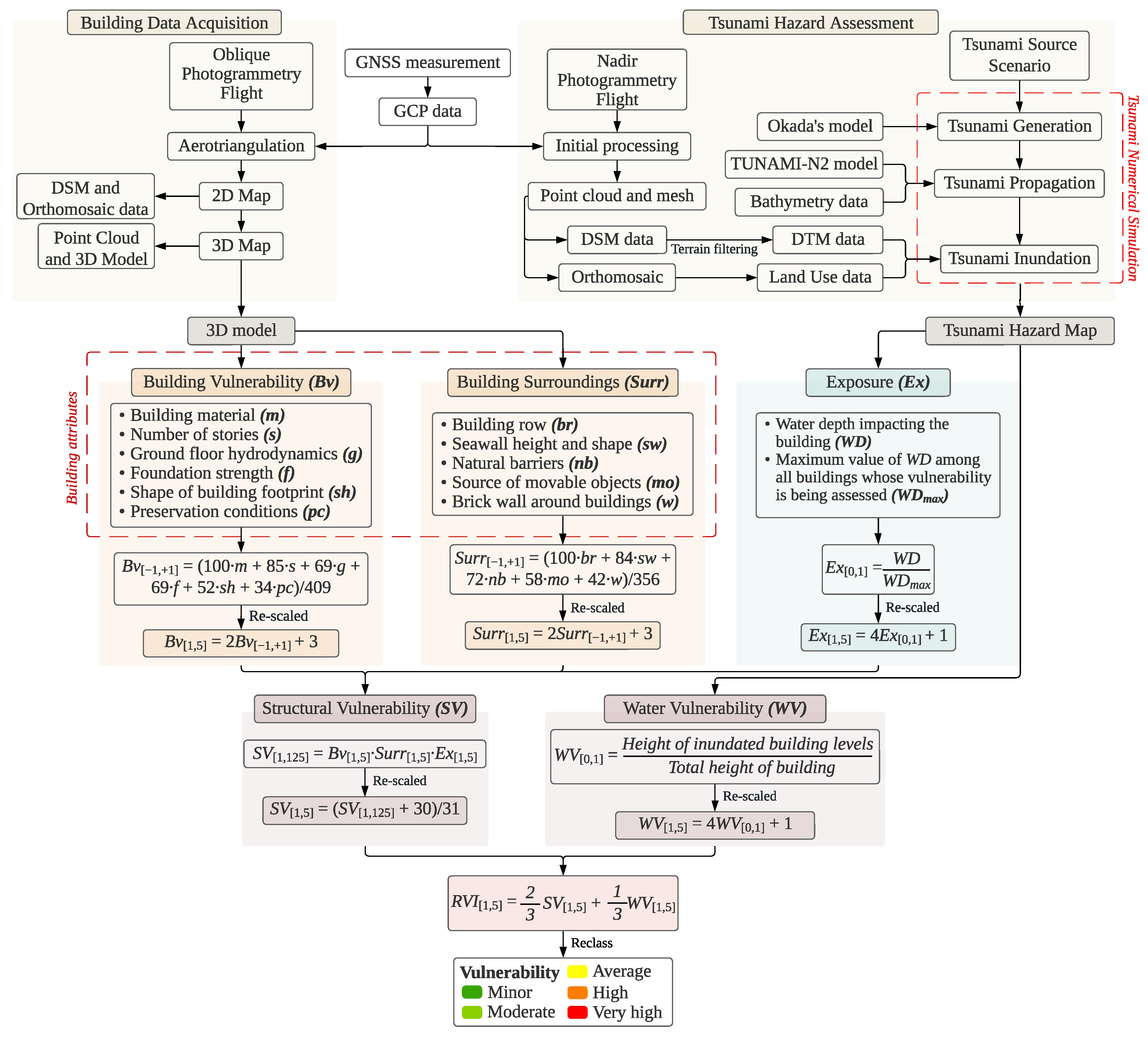
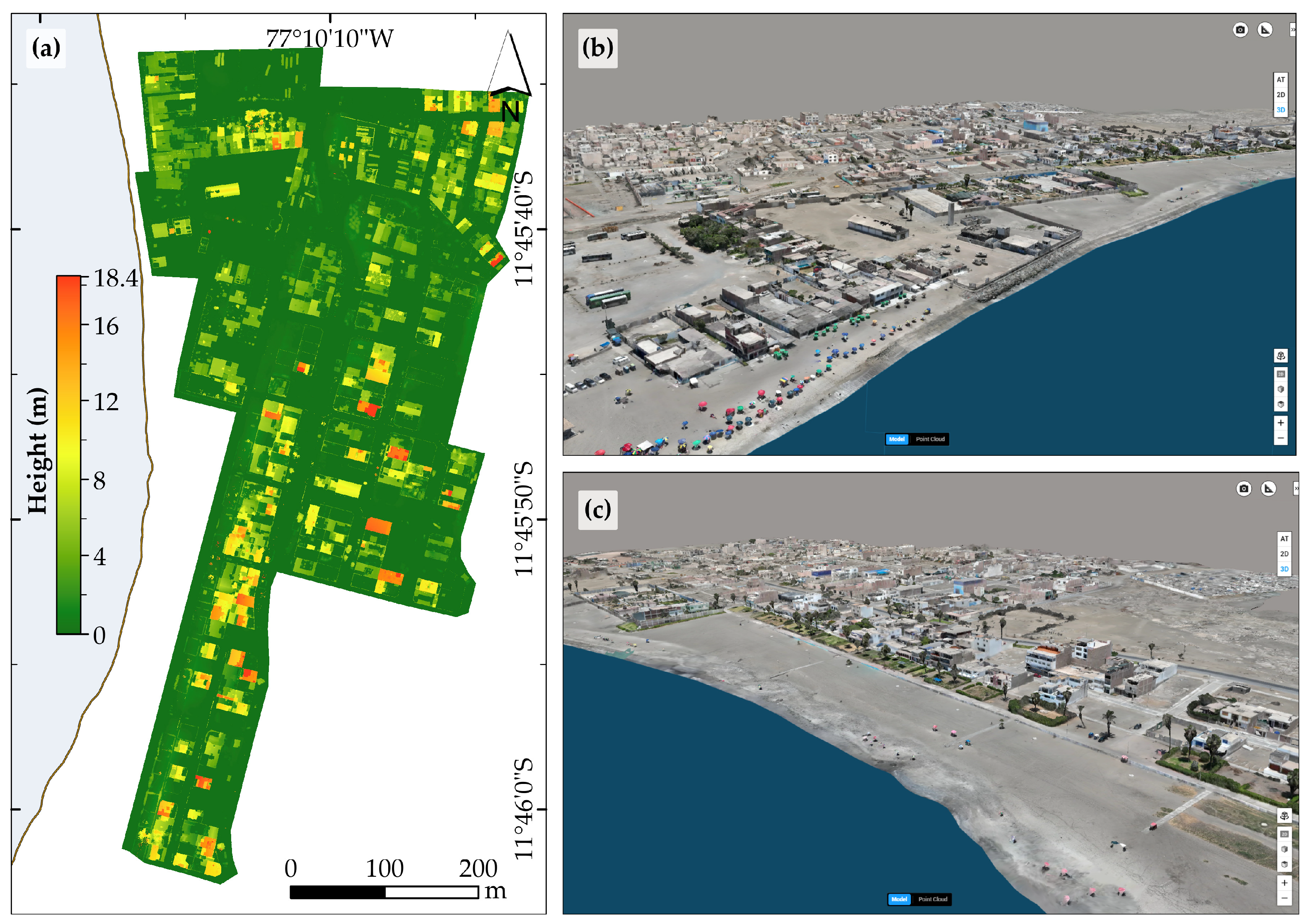
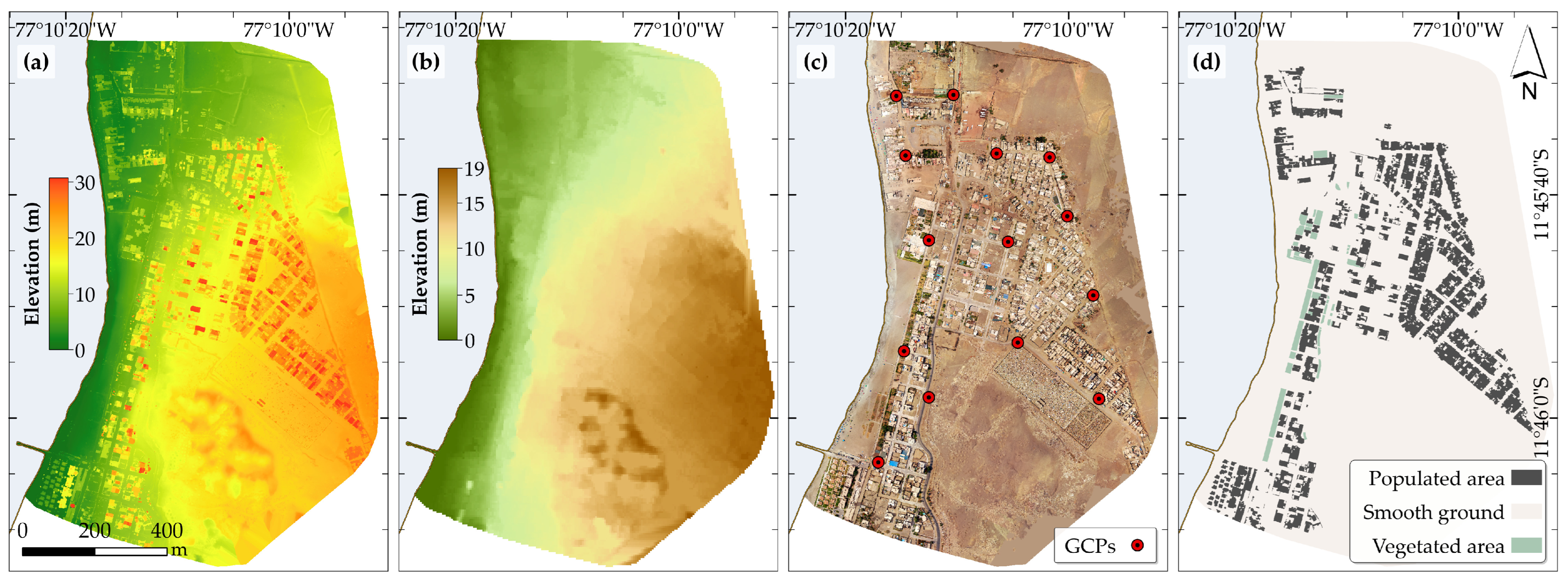
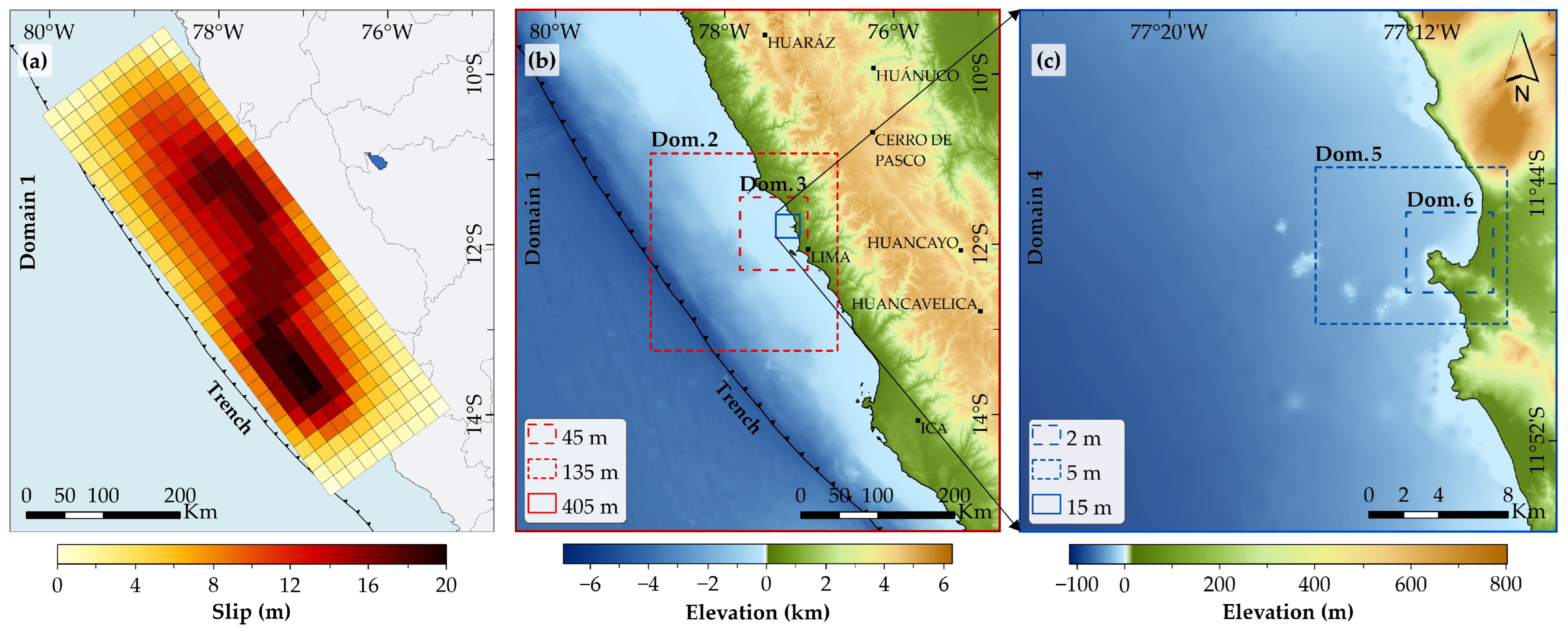
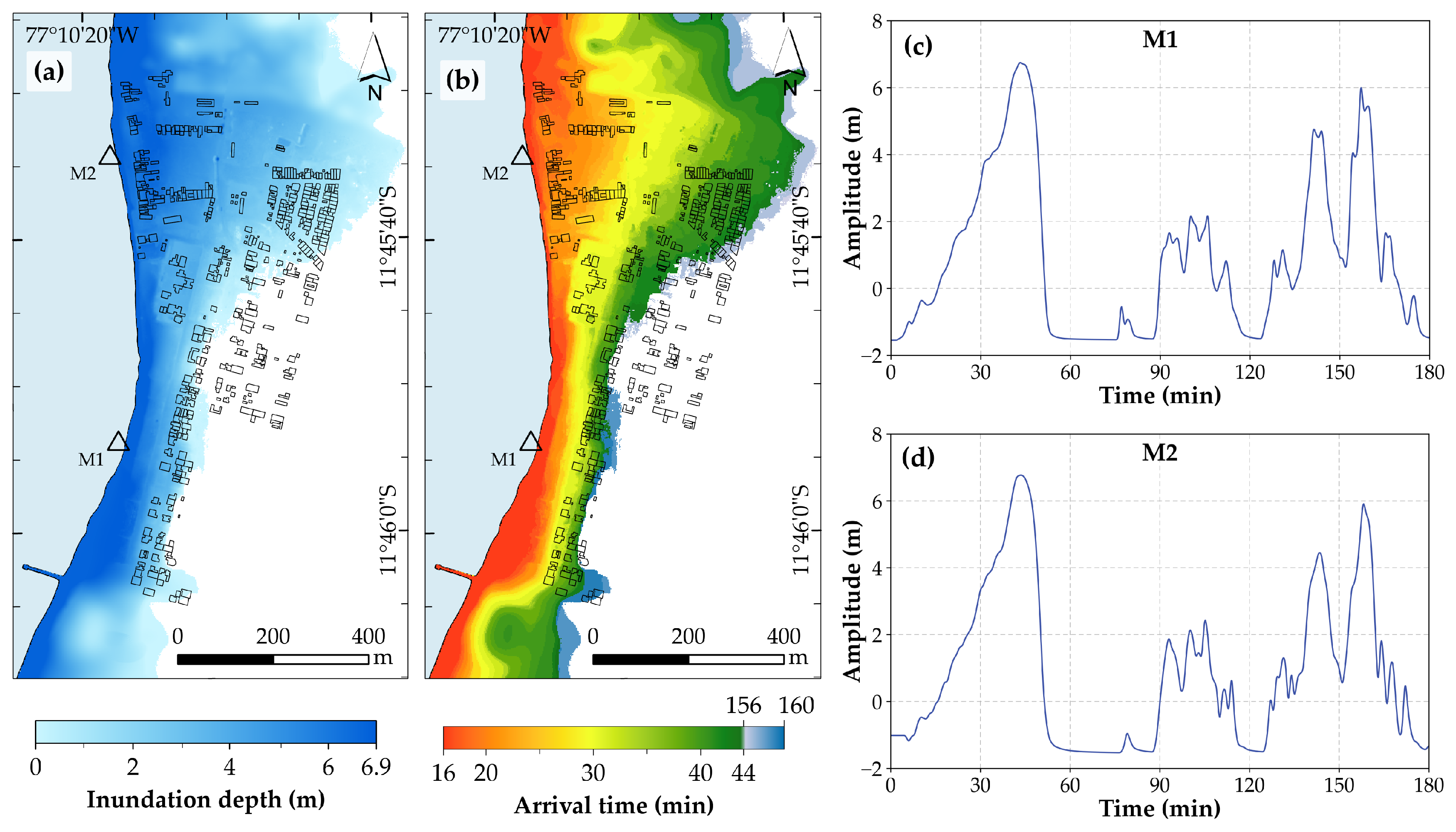
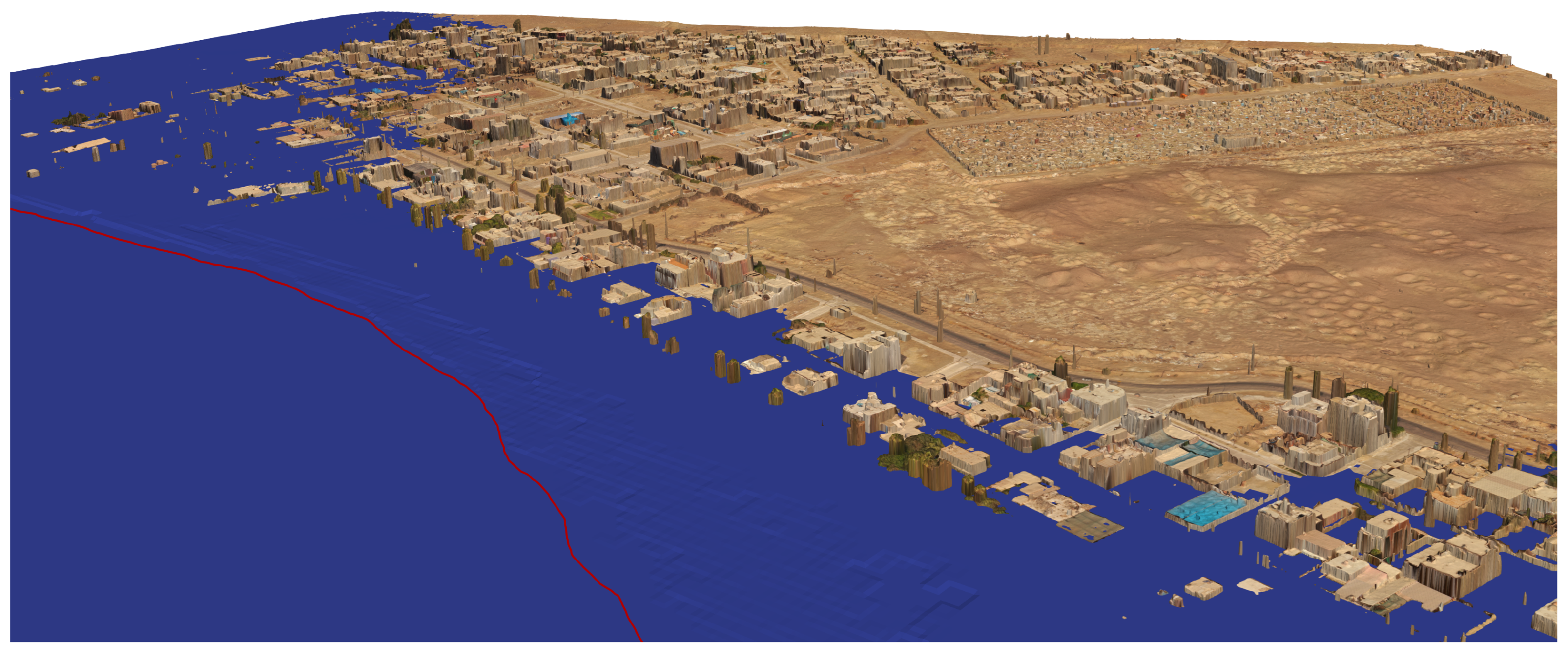
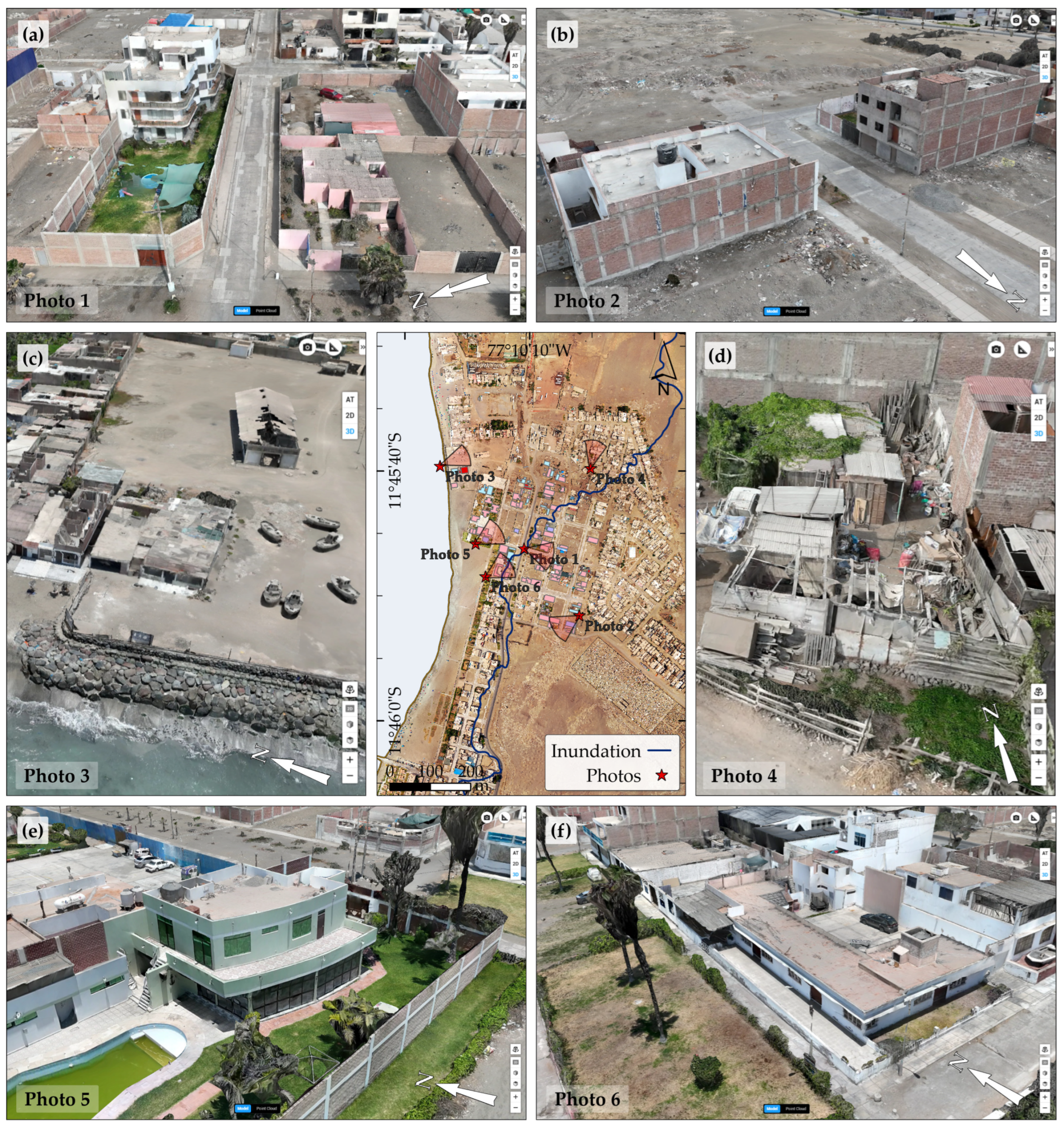

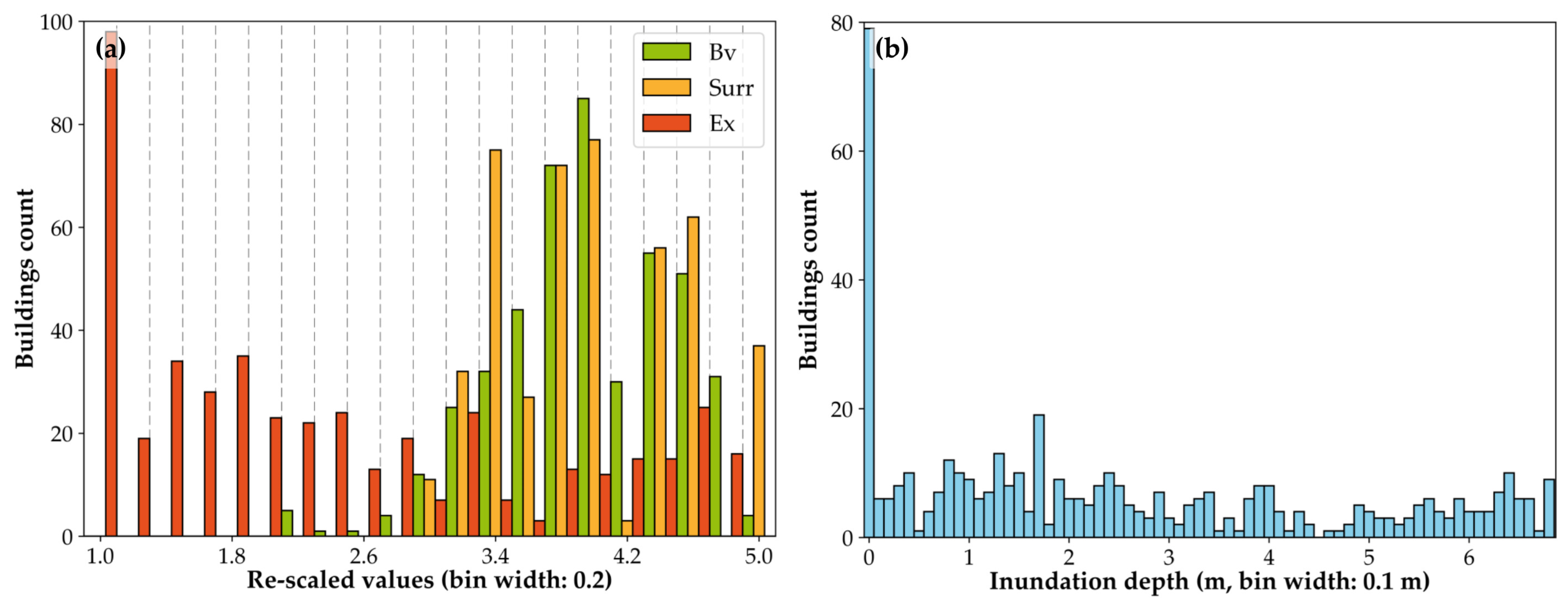

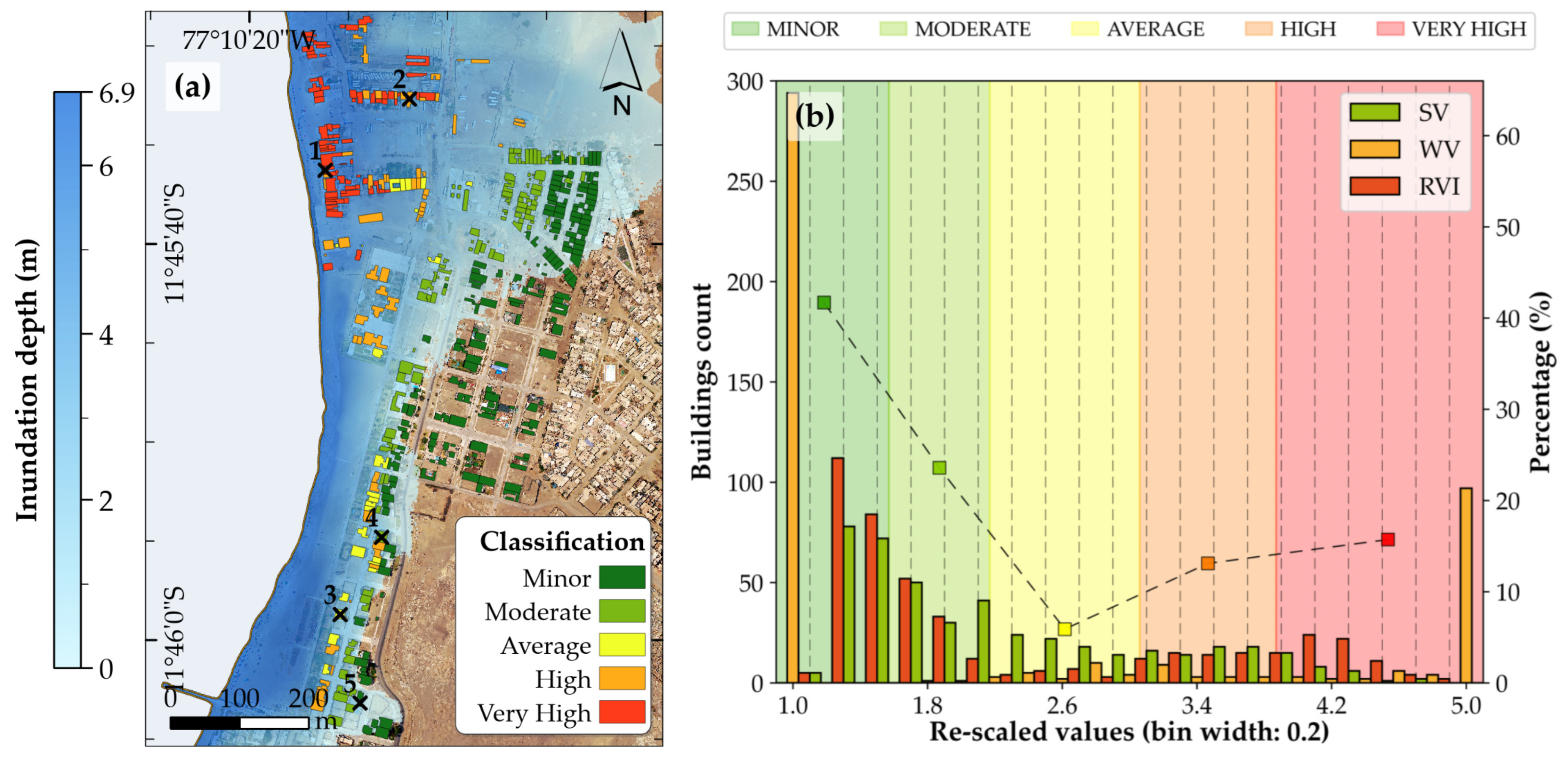
| Parameter | Oblique Photogrammetry | Nadir Photogrammetry |
|---|---|---|
| UAV model | DJI Mavic 3E | DJI Mavic 2 Pro |
| Camera | 4/3″ CMOS, 20 MP | 1″ CMOS, 20.2 MP |
| Tilt angle | 45° | 90° |
| Number of flights | 4 | 2 |
| Total flight duration | 92 min | 27 min |
| Ground Sample Distance | 3 cm | 18.5 cm |
| Flight height | 60 m | 195 m |
| Number of photos | 2900 | 553 |
| Processing software | DJI Terra | Pix4Dmapper |
| Covered area | 25 Ha | 110 Ha |
| Products * | nDSM and 3D Model | DSM, DTM, and DOM |
| Level | Minor | Moderate | Average | High | Very High |
|---|---|---|---|---|---|
| Value | 0 | +0.5 | +1.0 | ||
| m (building | RC | - | Masonry | - | Timber |
| material) | (1%) | (68%) | (31%) | ||
| s (number of | ≥5 | 4 | 3 | 2 | 1 |
| stories) | (0%) | (2%) | (8%) | (24%) | (66%) |
| g (ground floor | 100% | About 75% | About 50% | About 25% | 0 % |
| hydrodynamics) 1 | (2%) | (1%) | (19%) | (46%) | (32%) |
| f (foundation | Deep pile | - | Average-depth | - | Shallow |
| strength) | (0%) | (20%) | (80%) | ||
| sh (shape of | Round/Triangular | Almost squared | Rectangular | Lengthened | Complex |
| building footprint) | (0%) | (28%) | (41%) | (18%) | (13%) |
| pc (preservation | Very good | Good | Average | Poor | Very poor |
| condition) | (0%) | (4%) | (55%) | (29%) | (12%) |
| br (building | >10th | 7–8–9–10th | 4–5–6th | 2nd–3rd | 1st |
| row) | (0%) | (22%) | (29%) | (30%) | (19%) |
| sw (seawall height | Vertical > 5 m | Vertical 3–5 m | Vertical 1.5–3 m | Sloped 1.5–3 m | None |
| and shape) | (0%) | (0%) | (0%) | (2%) | (98%) |
| nb (natural | Very high | High | Average | Moderate | None |
| barrier) 2 | (0%) | (0%) | (0%) | (0%) | (100%) |
| mo (source of | Very low | - | Average | - | Very high |
| movable objects) 3 | (58%) | (14%) | (29%) | ||
| w (brick wall | >80% | 60–80% | 40–60% | 20–40% | 0–20% |
| around buildings) 4 | (19%) | (3%) | (2%) | (3%) | (73%) |
| Building | Description | Inundation | RVI Score | Vulnerability | Photo |
|---|---|---|---|---|---|
| ID | Depth (m) | [1–5] | |||
| 1 | Restaurant | 6.46 | 4.49 | Very High |  |
| 2 | Restaurant | 5.25 | 3.63 | High | 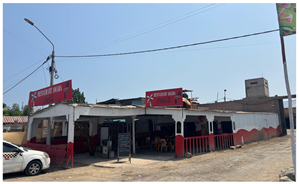 |
| 3 | Dwelling | 3.78 | 2.76 | Average | 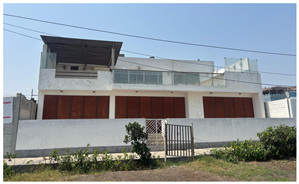 |
| 4 | Hotel | 3.25 | 2.10 | Moderate | 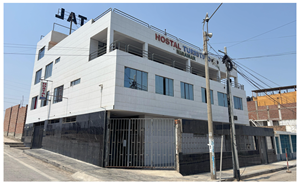 |
| 5 | School | 0.66 | 1.47 | Minor |  |
Disclaimer/Publisher’s Note: The statements, opinions and data contained in all publications are solely those of the individual author(s) and contributor(s) and not of MDPI and/or the editor(s). MDPI and/or the editor(s) disclaim responsibility for any injury to people or property resulting from any ideas, methods, instructions or products referred to in the content. |
© 2025 by the authors. Licensee MDPI, Basel, Switzerland. This article is an open access article distributed under the terms and conditions of the Creative Commons Attribution (CC BY) license (https://creativecommons.org/licenses/by/4.0/).
Share and Cite
Davila, C.; Quesquen, A.; Garcia, F.; Puchoc, B.; Solis, O.; Palacios, J.; Morales, J.; Estrada, M. Assessment of Building Vulnerability to Tsunami in Ancon Bay, Peru, Using High-Resolution Unmanned Aerial Vehicle Imagery and Numerical Simulation. Drones 2025, 9, 402. https://doi.org/10.3390/drones9060402
Davila C, Quesquen A, Garcia F, Puchoc B, Solis O, Palacios J, Morales J, Estrada M. Assessment of Building Vulnerability to Tsunami in Ancon Bay, Peru, Using High-Resolution Unmanned Aerial Vehicle Imagery and Numerical Simulation. Drones. 2025; 9(6):402. https://doi.org/10.3390/drones9060402
Chicago/Turabian StyleDavila, Carlos, Angel Quesquen, Fernando Garcia, Brigitte Puchoc, Oscar Solis, Julian Palacios, Jorge Morales, and Miguel Estrada. 2025. "Assessment of Building Vulnerability to Tsunami in Ancon Bay, Peru, Using High-Resolution Unmanned Aerial Vehicle Imagery and Numerical Simulation" Drones 9, no. 6: 402. https://doi.org/10.3390/drones9060402
APA StyleDavila, C., Quesquen, A., Garcia, F., Puchoc, B., Solis, O., Palacios, J., Morales, J., & Estrada, M. (2025). Assessment of Building Vulnerability to Tsunami in Ancon Bay, Peru, Using High-Resolution Unmanned Aerial Vehicle Imagery and Numerical Simulation. Drones, 9(6), 402. https://doi.org/10.3390/drones9060402













